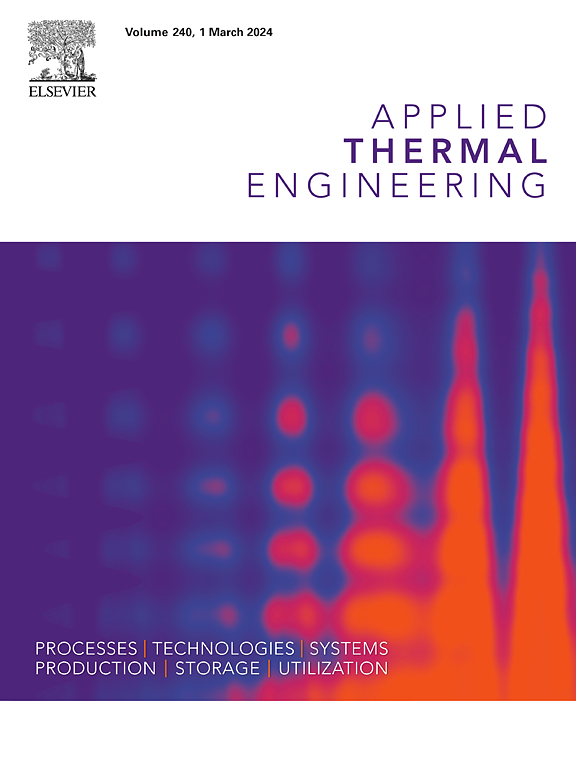Experimental study on cooling and dehumidification performance of a novel radiant-convective terminal based on micro heat pipe array
IF 6.9
2区 工程技术
Q2 ENERGY & FUELS
引用次数: 0
Abstract
Conventional radiant terminal systems face limitations such as surface condensation, insufficient cooling capacity, and inability to manage latent loads. These issues complicate air conditioning systems and slow thermal response, making it challenging to achieve efficient cooling and dehumidification simultaneously. This study introduces a novel radiant-convective terminal based on a micro heat pipe array which integrates cooling and dehumidification functions. This design improves heat transfer efficiency and accelerates system response via forced convection. Experiments were conducted to investigate the effects of water supply temperature, water flow rate, and wind speed on the terminal’s cooling and dehumidification performance. Additionally, a quantitative analysis of its performance characteristics was carried out. The results demonstrate that, under forced convection conditions, the thermal response speed of the terminal is significantly enhanced, with the surface temperature stabilizing within approximately 20 min. When the water supply temperature is 8 °C, the water flow rate is 400 L/h, and the wind speed is 1.5 m/s, the cooling capacity reaches 617.1 W/m2, with latent heat transfer accounting for 25 %, and the dehumidification capacity achieving 0.44 kg/h. After comparison, the terminal’s unit area cooling capacity is 498 % of the traditional radiant terminal’s, and its dehumidification capacity is 64 % of the integrated cooling and dehumidification terminal’s. Experimental data were used to derive the correlation between cooling capacity and excess temperature, as well as the expression for dehumidification capacity. This study provides theoretical and experimental foundations for designing and optimizing the novel radiant terminal, offering valuable insights for high-efficiency cooling and dehumidification systems.
基于微热管阵列的新型辐射对流终端冷却除湿性能实验研究
传统的辐射终端系统面临诸如表面冷凝、冷却能力不足和无法管理潜在负载等限制。这些问题使空调系统复杂化,热响应缓慢,使得同时实现高效冷却和除湿具有挑战性。本文介绍了一种基于微热管阵列的新型辐射对流终端,该终端集冷却和除湿功能于一体。这种设计提高了传热效率,并通过强制对流加速系统响应。通过实验研究了供水温度、水流流速和风速对终端制冷除湿性能的影响。并对其性能特性进行了定量分析。结果表明:在强制对流条件下,终端的热响应速度显著提高,表面温度在20 min左右稳定。当供水温度为8℃,水流量为400 L/h,风速为1.5 m/s时,制冷量达到617.1 W/m2,潜热占25%,除湿量达到0.44 kg/h。经比较,该终端的单位面积制冷量为传统辐射终端的498%,除湿量为制冷除湿一体化终端的64%。利用实验数据推导出制冷量与超温的关系,以及除湿量的表达式。该研究为新型辐射终端的设计和优化提供了理论和实验基础,为高效制冷和除湿系统提供了有价值的见解。
本文章由计算机程序翻译,如有差异,请以英文原文为准。
求助全文
约1分钟内获得全文
求助全文
来源期刊

Applied Thermal Engineering
工程技术-工程:机械
CiteScore
11.30
自引率
15.60%
发文量
1474
审稿时长
57 days
期刊介绍:
Applied Thermal Engineering disseminates novel research related to the design, development and demonstration of components, devices, equipment, technologies and systems involving thermal processes for the production, storage, utilization and conservation of energy, with a focus on engineering application.
The journal publishes high-quality and high-impact Original Research Articles, Review Articles, Short Communications and Letters to the Editor on cutting-edge innovations in research, and recent advances or issues of interest to the thermal engineering community.
 求助内容:
求助内容: 应助结果提醒方式:
应助结果提醒方式:


